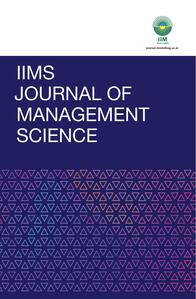
1 School of Business, ITM (SLS) Baroda University, Vadodara, Gujarat, India
Creative Commons Non Commercial CC BY-NC: This article is distributed under the terms of the Creative Commons Attribution-NonCommercial 4.0 License (http://www.creativecommons.org/licenses/by-nc/4.0/) which permits non-Commercial use, reproduction and distribution of the work without further permission provided the original work is attributed.
Social media has become an integral part of people’s lives. Extant research is full of ample evidence on the impact of social media on the brand image and purchase intentions of consumers. Educational institutions have started using social media for passing information and influencing the attitudes of prospective students. There is a dearth of research on the type of content that can be used on social media to build the desired brand image as well as influence the attitude of prospective students. This study has an objective of identifying the common themes of social media content that are used by the leading IIMs, that is, IIM Ahmedabad, IIM Bangalore and IIM Calcutta. Additionally, another aim is to find the themes that drive maximum engagement. Data was extracted from Facebook and Instagram posts of IIM Ahmedabad, Bangalore and Calcutta for a period of 8 months (i.e., January 2022 to August 2022). The posts were categorized on the basis of commonality and were given a common theme for analysis. Simple descriptive statistics was used to analyse the data. Frequency and mean were used to identify the most popular themes and correlation was used to find the relationship between the number of posts and engagement. Text analysis was also done using word cloud. On the basis of the post content and most frequently used words on all three platforms, word cloud was built for the three institutions. It was found that the most engaging themes on Facebook were achievements, webinars, festival celebrations, public talks by experts and appreciation posts. Similarly, the most engaging themes on Instagram were university infrastructure, webinars, achievements, cultural events and festival celebrations, Furthermore, the most engaging themes on LinkedIn were farewell, inauguration, festival celebration, social events and virtual meetings. The results of this study will contribute to the extant literature on what branding themes can be used by educational institutions on social media platforms to maximize engagement.
Social media analytics, brand image, content marketing, brand attitude, content analysis
Introduction
As technology has evolved, human beings have started preferring virtual environments for interaction rather than face-to-face interactions (del Rocío Bonilla et al., 2020). This phenomenon has affected the way service industries build relationships with their stakeholders. The omnipresent nature of social media has made it possible in portraying multiple roles. These include social media as a marketing and recruitment tool, network facilitator, teaching and learning tool and collaboration (Benson & Morgan, 2018). Social media marketing has received increased attention, especially in the marketing of higher education (Lee et al., 2020). The current generation is very aggressive when it comes to the use of social media as they spend a substantial amount of time in surfing. Universities take this as an opportunity for brand building and student recruitment (Motta & Barbosa, 2018). Most of the universities, especially in the Western world and more recently even in Asian countries have social media pages and are active on many social media platforms (Brech et al., 2017). Recent work in higher education marketing has evidence with regard to the effect of social media marketing on the brand equity of higher education institutions (Perera et al., 2022). Universities invest in paid advertisements for marketing but more so on user-generated content to influence decisions and brand perceptions among prospective students (Chen et al., 2011). Extant literature has shown that about 40% of information prospective students source is from social media (Lee & Lam, 2016). However, there are challenges with respect to getting the desired level of engagement on social media platforms. Notwithstanding the merits of social media, dealing with an elusive user merits substantial scrutiny. Being a public platform, higher education institutions should post the appropriate content to drive user engagement (Goh et al., 2013). Previous research supports the importance of social media marketing but lacks a framework on what can drive engagement on social media platforms (Perera et al., 2022). Oliveira and Figueira (2015) in their study on social media content analysis for higher education have emphasized on the lack of research studies in this area. Similarly, Qi and Mackie (2014) echoed a similar sentiment in their study on utilizing social media technology in higher education. This research is done with an aim to identify the themes that engage the users (viz, students) the most on popular social networking sites, that is, Facebook, Instagram and LinkedIn. Among the several research questions that this article attempts to address, the most pertinent ones are as follows: What should universities post on their social media platforms to effectively engage with users? Whether there is a relationship between the number of posts on social media platforms and engagement. What are the most frequently used themes utilized by IIM Ahmedabad, Bangalore and Calcutta for posting on their social media platforms? The results of this study will contribute immensely to this rapidly growing area of social media content analysis, especially in the field of higher education. Additionally, it will help practising social media managers and content strategists on themes that can drive traffic on their social media platforms.
Literature Review
Social Media Marketing in Higher Education
When marketers use social media to fulfil their goals, it is often referred to as social media marketing (Brech et al., 2017). Marketers of all sizes try to use social media for their marketing but not all of them are equally successful (Vernuccio, 2014). Similarly, universities and institutions of higher education have also tried social media marketing but again not all of them have been able to drive success on social media (Greenwood, 2012). Over the last two decades competition has flared up in the higher education market worldwide, it is therefore imperative for higher education institutions to market themselves well with a clear-cut marketing and branding strategy (Whisman, 2011). Universities are widely using social media platforms for marketing and branding (Galan et al., 2015). At the same time, universities are also investing largely in marketing to make their position competitive worldwide (Whisman, 2011). Scholars have posited that universities are using social media platforms for building a student community where information can be posted about campus life, student activities and strengthening students’ interaction and engagement (Davis et al., 2012). Tuten (2008) posits that as social media is a platform that drives active engagement, it is pivotal in building the desired brand image for universities. Extant literature states that for a university to be successful, it has to maintain strong relations with three key stakeholders, that is, current students, future students and alumni. The quality of these relations determines long-term loyalty towards the university (McAlexander & Koenig, 2001). Social media can aid in maintaining relations with its users due to its interactive nature. Literature with respect to the use of Social Media Marketing (SMM) by Higher Education Institution (HEIs) is limited; however, there is ample evidence on the successful utilization of SMM by universities and institutions in the United States (Barnes & Mattson, 2009). A recent study by Mai To et al. (2022) highlighted the importance of social media presence for marketing and branding purposes. In their study, they highlighted the key social media branding themes used by Canadian universities. Some researchers have highlighted the use of social media sites by prospective students for searching and choosing universities (Shields & Peruta, 2018; Le et al., 2019). Prospective students mostly look for information related to student life by reading information posted by students. They are also interested in searching for various job and career opportunities they might get from a university. A university can benefit by posting these snippets of information on its social media platforms (Galan et al., 2015). According to Salgado and Vela (2019), it is possible for universities to increase student loyalty by posting positive student experiences on social media platforms and websites. María Bonilla et al. (2019) posited that social media platforms have inherent advantages over traditional media for universities due to their interactive nature.
Indian Education Institutions on Social Networking Sites
There are a large number of social networking sites that are utilized by students for social networking, however, in context of India, the most popular ones are Instagram, Facebook and LinkedIn. These are relatively more popular and are also utilized by universities for their branding initiatives (Paladan, 2018). As per a leading social media portal, Facebook is the leading social media platform with the highest traffic at 58%, followed by Instagram with a traffic of 26.44%. LinkedIn is far from Facebook and Instagram but its traffic is increasing steadily with .33% (Statista, 2022). There are nearly 239.65 million users of Facebook in India, making it the country with the highest number of Facebook users. Instagram, a free application was launched in October 2010, is a hot favourite among the university-going audience of India, it has 230.25 million users in India, which is very close to Facebook. It is a social platform that allows users to post pictures with/without filters and run hashtag campaigns to increase the visibility of their posts among the social media community (Carah & Shaul, 2015; Hu et al., 2014). LinkedIn is a professional networking site, which has close to 87 million users in India (Statista, 2022). Majority of the Indian universities are active on social media platforms and have an account/page on all three popular social media platforms, that is, Facebook, Instagram and LinkedIn (Paladan, 2018). The top management institutions, that is, Indian Institute of Management Ahmedabad, Indian Institute of Management Bangalore and Indian Institute of Management Calcutta, popularly known as IIM (A, B and C) are very active on each of the above social media platforms. IIMA has 5.61 lakh followers on its Facebook page, 89k followers on Instagram and 262,237 followers on LinkedIn. IIMB has 41205 followers on Facebook, 57,500 followers on Instagram and 267,795 followers on LinkedIn, similarly, IIMC has 127,249 followers on Facebook, 29,200 followers on Instagram and 138,741 followers on LinkedIn.
Increasing Student Engagement on Social Media Platforms
Driving user engagement is one of the major goals as well as challenges that social media managers face. There are several studies in extant literature that highlight the factors/characteristics that can drive engagement on social media platforms. Some of them include vivid postings with pictures and calls for interaction. These kinds of posts drive the highest number of ‘likes’ (De Vries et al., 2012; Rauschnabel et al., 2011). Similarly, Ashley and Tuten (2015) highlighted the importance of frequent updates and incentives for user participation as crucial factors for engagement. Likewise, experiential, exclusive and image-related messages also drive user engagement. Social media can also be used to build the symbolic image of a university by posting authentic insightful stories of students and university achievements. Researchers have found that users follow university social media pages as an act of self-expression and identification. They validate this feeling of self-expression by liking pages of universities they relate to (Batra et al., 2012; Holmberg & Strannegård, 2015). Besides self-expression, other motivations of following social media pages do exist. Information seeking and entertainment are other reasons for users to follow social media pages (Baldus et al., 2015). Many universities tend to fulfil the informational needs of their users by providing regular updates on their activities. Apart from self-expression and identification, prior research has highlighted that users express love for brands that they feel suit their actual/desired self-identity. Similarly, users on social media tend to follow/display a higher level of engagement with pages that match their self-identity. For example, Hollenbeck and Kaikati (2012) have posited that users follow Facebook brand pages to convey their self/desired identity among their social media community. It is therefore the cult/heritage university brands that have a higher number of followers. Another aspect that has often been talked about with respect to engagement is frequency of posting. It has been posited that social media pages with very few postings often are found to be boring and drive low level of engagement, similarly posting very frequently tends to be annoying and over-stimulating. The challenge is to keep the number of postings optimal. It has been found that intermediate posting drives maximum interaction and engagement (Brech et al., 2017). Evaluating the success and effectiveness of posts on social networks is one of the greatest challenges that marketers face (Maria Bonilla et al., 2019). As per Barger and Labrecque (2013), post engagement in the form of shares, likes and comments are considered to be manifestations of the success of a social media post, likes, shares and comments in the case of Instagram and Facebook; retweets and replies in the case of twitter (Hoffman & Fodor, 2010). There are several types of analytics tools available on social media platforms that measure the level of audience engagement.
What is missing in the literature is the common themes that can drive student engagement on social media platforms.
Methodology
We chose to utilize secondary data, that is, social media posts on Facebook, Instagram and LinkedIn of the top three management institutions of India, that is, Indian Institute of Management Ahmedabad, Indian Institute of Management Bangalore and Indian Institute of Management Calcutta, popularly known as IIM (A, B and C). The design of this study is exploratory in nature. The research population was social media posts of IIM (A, B and C) on Facebook, Instagram and LinkedIn. The sampling frame was from January 2022 to August 2022 (8 months). The sample size of Facebook posts was 502, Instagram was 438 and LinkedIn was 717. The total sample size taking all three social networking sites was 1,657 posts. The sampling technique was non-probability purposive sampling, as the researcher chose the most recent posts. The posts were categorized on the basis of commonality and were given a common theme for analysis. Simple descriptive statistics was used to analyse the data. Frequency and mean were used to identify the most popular themes and correlation was used to find the relationship between number of posts and engagement. A text analysis was also done using word cloud. Descriptive analysis was done using Microsoft Excel and word cloud was generated using ‘freewordcloudgenerator’ an open-source platform. Correlation analysis was performed using IBM SPSS. Text was extracted from the social media posts of IIM (A, B and C) on Facebook, Instagram and LinkedIn. On the basis of the post content and most frequently used words on all three platforms, word cloud was built for the three institutions.
Results
Social Media Post Analysis Using Descriptive Statistics and Correlation
Facebook Content Analysis
On analysing the Facebook page content of IIMA, it was found that posts related to webinar (197), achievement (168), appreciation (156), infrastructure (147) and seminar (135) were found to attract the maximum number of likes. The appreciation-related posts were few (5) in number (Table 1), but they drove a considerable number of likes (156). IIM Ahmedabad has 561,000 followers on its Facebook page, which it created on 11 August 2011. Similarly for IIM Bangalore, it was found that posts related to festival celebration (150), public talks (132), infrastructure (125), achievements (116) and book launch (94) were found to attract the maximum number of likes. The appreciation and achievement-related posts were few (9) in number (Table 2), but they drove a considerable number of likes (116 and 94). IIM Bangalore had 41,205 followers on its Facebook page, which it created on 6 August 2013. Similarly, in the case of Facebook content of IIM Calcutta, it was found that posts related to public talks (161), appreciation (158), webinar (144), achievements (137) and festival celebrations (131) were found to attract the maximum number of likes. The appreciation- and achievement-related posts were few (6 and 5) in number (Table 3), but they drove a considerable number of likes (158 and 137). IIM Calcutta had 127,249 followers on its Facebook page, which it created on 27 February 2010. For all the three institutions, achievements and appreciation posts drove the maximum number of likes.
Table 1. Facebook Content Analysis of IIMA.

Table 2. Facebook Content Analysis of IIM Bangalore.
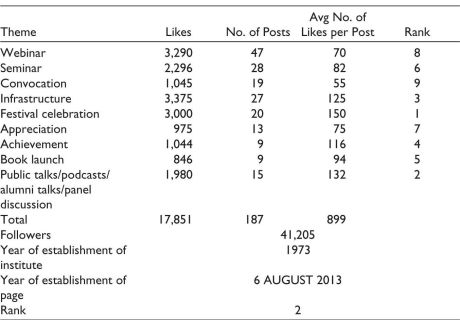
Table 3. Facebook Content Analysis of IIMC.
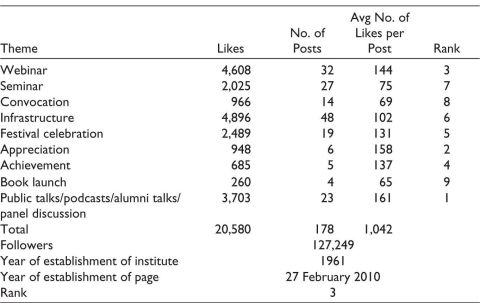
Instagram Content Analysis
On analysing the Instagram content of IIMA, it was found that posts related to webinars (2,998), infrastructure (2,651), application updates (2,356), achievements (2,031) and appreciation (1,758) were found to attract the maximum number of likes. The application updates, webinar and achievements-related posts were few (1, 3 and 3) in number (Table 4), but they drove a considerable number of likes (2,356, 2,998 and 2,031). IIM Ahmedabad has 89,000 followers on its Instagram page. Similarly, the Instagram content of IIMB was analysed, it was found that posts related to infrastructure (2,987), achievements (2,055), cultural events (1,952), academic appreciation (1,450) and sports celebration (1,353) were found to attract the maximum number of likes. The achievements, cultural events and sports celebration-related posts were few (3, 2 and 4) in number (Table 5), but they drove a considerable number of likes (2,055, 1,952 and 1,353). IIM Bangalore has 57,500 followers on its Instagram page. Furthermore, on analysing the Instagram content of IIMC, it was found that posts related to festival celebrations (1,583), cultural events (1,512), infrastructure (1,423), inauguration and orientation (1,321) and virtual meetings (1,301) were found to attract the maximum number of likes. The festival celebration, cultural events and inauguration and orientation-related posts were few (7, 6 and 2) in number (Table 6) but they drove a considerable number of likes (1,583, 1,512 and 1,321). IIM Calcutta has 29,200 followers on its Instagram page.
Table 4. Instagram Content Analysis of IIMA.
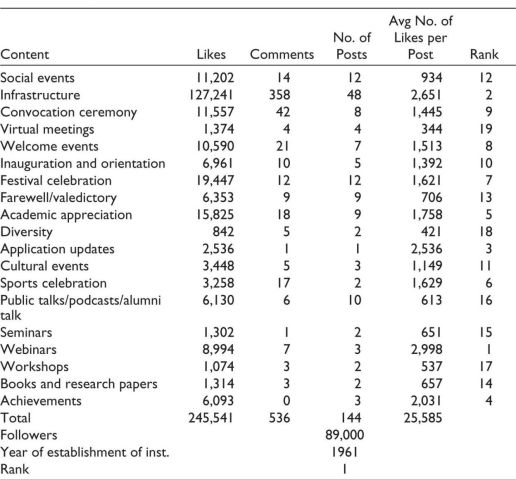
Table 5. Instagram Content Analysis of IIMB.
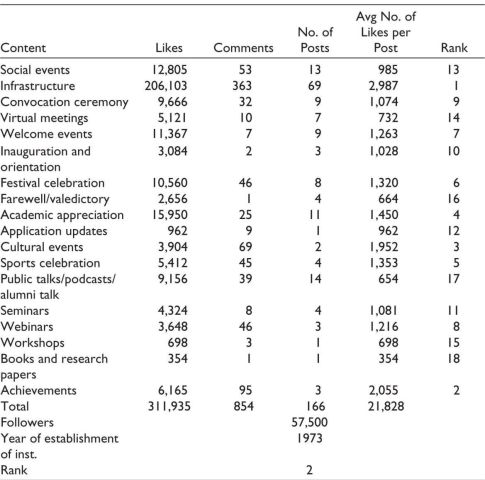
Table 6. Instagram Content Analysis of IIMC.
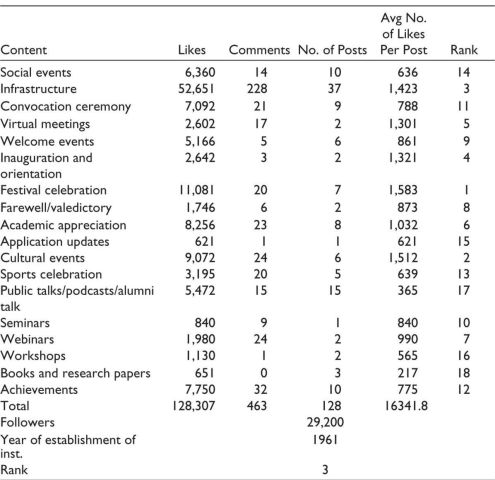
LinkedIn Content Analysis
On analysing the LinkedIn page content of IIMA, it was found that posts related to farewell (202), article/report (198), inauguration (192), workshop (190) and festival celebration (168) were found to attract the maximum number of likes. The workshop and farewell-related posts were few (5 and 6) in number (Table 7), but they drove a considerable number of likes (954 and 1,212). IIM Ahmedabad had 262,237 followers on its LinkedIn page. Similarly, on analysing the LinkedIn page content of IIMB, it was found that posts related to welcoming event (279), farewell (240), inauguration (218), charity (187) and public talks (163) were found to attract the maximum number of likes. The welcoming, farewell, inauguration and charity related posts were few (3, 3, 6 and 3) in number (Table 8), but they drove a considerable number of likes (279, 240, 218 and 187). IIM Bangalore had 267,975 followers on its LinkedIn page. Furthermore, on analysing the LinkedIn page content of IIMC, it was found that posts related to virtual meetings/online programmes (256), workshops (237), appreciation (227), social events (216) and celebrations (205) were found to attract the maximum number of likes. The workshop achievement and inauguration-related posts were few (8, 4 and 9) in number (Table 9), but they drove a considerable number of likes (237, 187 and 178). IIM Calcutta had 138,741 followers on its LinkedIn page.
Table 7. LinkedIn Content Analysis of IIMA.

Table 8. LinkedIn Content Analysis of IIMB.
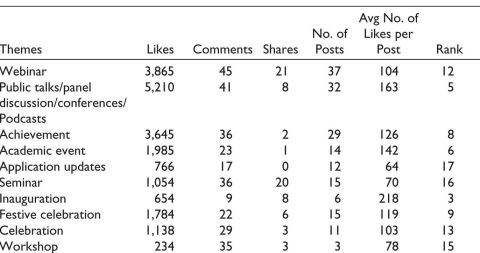

Table 9. LinkedIn Content Analysis of IIMC.
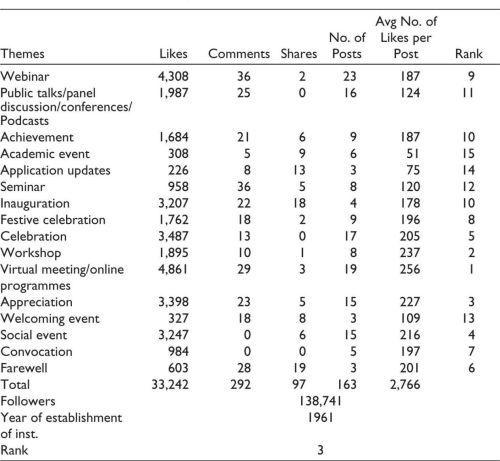
Maximum Engagement on Facebook, Instagram and LinkedIn
It was found that IIM Bangalore was able to drive maximum engagement on its Facebook page and Instagram page in comparison to IIM Ahmedabad and Calcutta. During the period of January 2022 to August 2022, it shared 187 posts on its Facebook page and 166 posts on its Instagram page, which attracted 17,851 likes and 311,935 likes, respectively. The engagement rate on the Facebook posts was 43.32% and Instagram was 542.49% (Table 10 and Table 11). Similarly, it was found that that IIM Calcutta was able to drive maximum engagement on its LinkedIn page. During the period of January 2022 to August 2022, it shared 163 posts on its LinkedIn page, which attracted 138,741 likes with an engagement* of 23.95% (Table 12). The formula used for calculation of engagement was taken from Trunfio and Rossi (2021): (Engagement = likes/followers × 100).
Table 10. Percentage Engagement of all IIMs on Facebook.

Table 11. Percentage Engagement of all IIMs on Instagram.

Table 12. Percentage Engagement of all IIMs on LinkedIn.

Note: *Only likes have been considered, other options like love, insightful, celebrate and funny have not been considered.
Correlation between Posts and Engagement on Facebook
It was found that there was a significant positive correlation between the number of posts and engagement on Facebook, r (185) = 0.614, p < .05, Instagram, r (176) = 0.324, p < .05 and LinkedIn, r (135) = 0.499, p < .01 (Table 13).
Table 13. Correlation between Number of Posts and Engagement on Facebook, Instagram and LinkedIn.

Note: ** Correlation is significant at the 0.05 level (2-tailed).
Most Engaging Themes on Facebook, Instagram and LinkedIn
It was found that the top five engaging themes for promotion on Facebook were achievements (421 likes per post), webinars (421 likes per post), festival celebrations (410 likes per post), public talks by experts (398 likes per post) and appreciation (389 likes per post). Similarly, the top five engaging themes for promotion on Instagram were infrastructure (7,061 likes per post), webinars (5,204 likes per post), achievements (4,861 likes per post), cultural events (4,613 likes per post) and festival celebrations (4,524 likes per post). Furthermore, the top five engaging themes for promotion on LinkedIn were farewell (643 likes per post), inauguration (588 likes per post), festival celebration (483 likes per post), social events (482 likes per post) and virtual/online meetings (474 likes per post) (Tables 14–17).
Table 14. Most Engaging Themes for Promotion on Facebook.
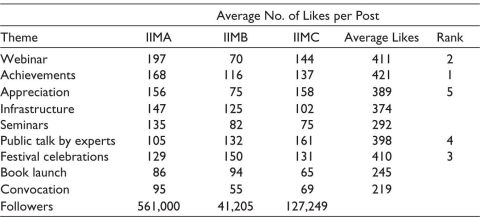
Table 15. Most Engaging Themes for Promotion on Instagram.

Table 16. Most Engaging Themes for Promotion on LinkedIn.
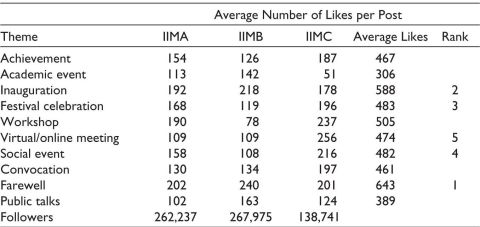
Table 17. Comparison of Facebook, Instagram and LinkedIn Pages of IIM (A, B and C).

Text Analysis of Facebook Posts Using Word Cloud
Text analysis of IIMA posts revealed that the most commonly used words by IIM Ahmedabad on its Facebook posts were leadership, research, Ashank Desai centre for leadership, strategy, AI, alumni, data, economy, on-campus courses, digital, webinar, international, marketing, executive education and the like. Majority of the posts highlighted research, leadership and executive education as salient differentiators and USPs of IIMA. IIM Bangalore Facebook posts revealed the multidimensional positioning that it intended to create using non-academic themes like har ghar tiranga, climate change concerns, amrit mahotsav and vista (the annual business summit that includes academic and cultural competitions) (Figures 1–3). Apart from non-academic themes, the institute had an equal focus on academic themes like research, data analytics, entrepreneurship, faculty achievements (book launches), leadership, entrepreneurship summit and NRCEL (incubation centre for startups). Additionally, there was emphasis on women-oriented themes and eradicating inequality. Text analysis of IIM Calcutta revealed its focus on industry interface through its focus on management development programs, leadership, awards, CEO series and executive education. Other frequently used words were vision, national, global, research, data, pride, growth, CEO and so on. There was emphasis on convocation, alumnus, marketing, global, national and growth. The positioning of IIM Calcutta was very similar to IIMA in terms of post content and themes.
Figure 1. Word Cloud of Facebook Content of IIM Ahmedabad, Bangalore and Calcutta.

Figure 2. Word Cloud of Facebook Content of IIM Bangalore.

Figure 3. Word Cloud of Facebook Content of IIM Calcutta.

Text Analysis of Instagram Posts Using Word Cloud
It was found that the most repeatedly used words by IIMA on its Instagram posts were leadership, research, webinar, science, development, analytics, artificial intelligence, Vikram Sarabhai, Louis Kahn Plaza, Ashank Desai centre for leadership development and community. It was evident that IIMA used the above words more often in its post highlighting a more rational and educational focused positioning but Instagram being a more image-oriented platform, words/themes like memories, LGBTQ, alumni, red, welcome, club, on-campus experiences, convocation and such light-hearted and nostalgia invoking themes have also found way in the body copy of the posts (Figures 4–6).
Figure 4. Word Cloud of Instagram Content of IIM Ahmedabad.

Figure 5. Word Cloud of Instagram Content of IIM Bangalore.
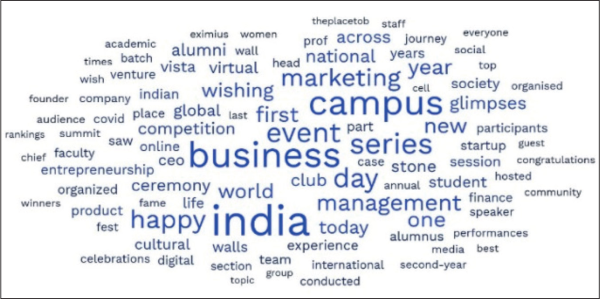
Figure 6. Word Cloud of Instagram Content of IIM Calcutta.

Most repeatedly used words by IIMB on its Instagram posts were campus, startup, alumni, fest celebrations, experience, startup, competitions, executive program, faculty, the place to be, eximius (entrepreneurship summit) and winners. It was clear that IIMB used the above words more often in its post highlighting a more youth-oriented positioning. Other words that found their way into the body copy of their Instagram posts were happy, journey, fest, celebrations and vista (cultural fest), journey, congratulations and performance. IIM Bangalore was very clear in its lively, vivid and colourful positioning it wanted to create on Instagram.
The most commonly used words by IIMC on its Instagram posts were MDP, leaders, research, industry executive program, convocation, global, data, international collaboration, analytics, alumni, success and so on. These words were well in sync with the posts on Facebook, whereby it wants to position itself as a more rational, academic oriented and traditional institute. Some other words that found way into the body copy of its Instagram posts were pride, love, congratulate, Joka, etc. These words/themes were utilized to appeal to give the institute a youthful appeal along with a more corporate-oriented theme.
Text Analysis of LinkedIn Posts Using Word Cloud
It was found that the most commonly used words by IIMA on its LinkedIn posts were leadership, business, development, marketing, research, science, analytics, alumni, webinar, executive development, Ashank Desai centre for leadership development, workshop and centre for logistics and transportation. Other words highlighted in the body copy of its LinkedIn page were data, transportation, alumni, strategy, economy and digital. Unlike the Instagram posts of IIM Ahmedabad, light-hearted themes did not find way in the LinkedIn posts of IIM Ahmedabad. LinkedIn being a platform for professionals, the posts reflected its academic and professional-oriented positioning. Similarly, the most commonly used words by IIMB on its LinkedIn posts were innovation, leadership, business, conference, learning, research, data and doctoral. Other words highlighted in the body copy of its LinkedIn page were alumni, innovation, competition, women, technology, international, alumni and marketing. IIMB had a sharp contrast in the positioning of its LinkedIn page in comparison to its Facebook and Instagram page, The body copy, design and colours of the posts on LinkedIn reflected its academic and innovation-based positioning. Furthermore, frequently used words by IIM Calcutta on its LinkedIn posts were management, business, alumnus, management development program, global, leaders, award, executive programs, digital, winners, CEO, development, success, strategic and so on. Other words highlighted in the body copy were congratulate, convocation, well-deserved, team and government. IIM Calcutta continued its focus on corporate interface and connect by highlighting its global approach, MBA executive and management development programs. The positioning of IIM Calcutta was similar to IIMA both being the oldest management institutes of India (Figures 7–9).
Figure 7. Word Cloud of LinkedIn Content of IIM Ahmedabad.
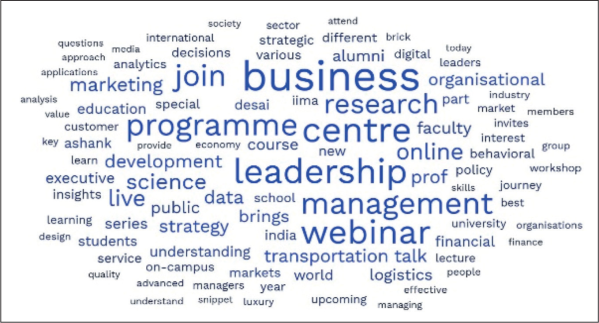
Figure 8. Word Cloud of LinkedIn Content of IIM Bangalore.
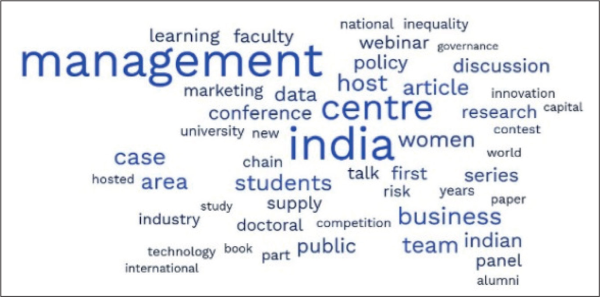
Figure 9. Word Cloud of LinkedIn Content of IIM Calcutta.

Discussion
Social media is here to stay, youngsters are glued to this medium for information, entertainment and networking. Penetration of internet and data is on an all-time high in developing countries. Considering this in the background education institutions have been active on social media platforms. What is lacking is a common framework, themes of what should be shared to maximize engagement on social media platforms. This study was been done with an intention to fill this gap. The purpose of this study was to identify the most engaging themes on social media platforms taking cues from the posts of IIM Ahmedabad, Bangalore and Calcutta, and second, to identify which IIM out of the three selected in this study has the maximum engagement on Facebook, LinkedIn and Instagram. Third, to investigate the correlation between posts and engagement. The study illustrates that the most engaging themes for promotion on social media were achievements of students, faculty and institutions, webinars on trending topics like AI, data analytics and digital transformation, festival celebrations, public talks by experts about entrepreneurship journey, network modelling, design thinking, financial inclusion, case-based pedagogy, data science, alumni journeys at IIMs, appreciation posts for placed students, infrastructure, cultural events, festival celebrations, farewell, inauguration, social events and virtual/online meetings. These results concur with the findings of Figueira (2018), whose study on data mining of the social media posts of top 5 higher education institutions in the world, concluded that celebration, happy, award, congratulations, prize, pride, etc., were the words that were frequently used on their social media platforms. Furthermore, the study illustrates that IIM Bangalore was able to drive maximum engagement on Facebook and Instagram through its vivid, vibrant and diverse content. in the other IIMs, that is, IIM Ahmedabad and IIM Calcutta posted content that was more academic in orientation. This was reflected in the engagement on LinkedIn, where IIM Calcutta was able to drive maximum engagement due to its content that was more industry focussed. It was also found that there was a positive correlation between number of posts and engagement in the case of Facebook, Instagram and LinkedIn. These results concur with the findings of Ashley and Tuten (2015) who posit that frequent updates on social media platforms are essential for user engagement. Furthermore, this result is in contrast to a study by Figueira (2018), where it was found that notwithstanding a smaller number of posts, Stanford University had a higher level of engagement in comparison to Harvard and MIT. This contrast in results can be attributed to the difference in culture between the countries where the research is conducted.
Implications of the Study
This article makes several contributions both to academia and industry. There are less descriptive studies about use of social media in higher education. This article extends theoretical knowledge on which social media themes can be used on Facebook, Instagram and LinkedIn to maximize engagement with stakeholders in higher education. Several branding themes frequently used by IIM Ahmedabad, Bangalore and Calcutta were identified. These themes will be useful for practicing social media managers to increase engagement and traffic on their social media platforms. Findings of this study add to the body of knowledge; themes that could maximize engagement for HEIs social media platforms. Findings of the study also highlighted frequent posting on social media platforms to maintain visibility. Additionally, this study highlights the need for social media managers to focus on the content for platforms like LinkedIn where the audience is different in comparison to Facebook and Instagram. LinkedIn demands content that is rational and appeals to the rational needs of the users.
Limitations and Future Research
The current study has considered the social media posts of only three management institutions, that is, IIM Ahmedabad, IIM Bangalore and IIM Calcutta. The results of content analysis cannot be generalized for a diverse set of institutions. The sampling duration considered in this study was 8 months, further studies can extend the duration for a longer period. Furthermore, the current study takes into consideration only three social media platforms, that is, Facebook, Instagram and LinkedIn, further studies can include other platforms like Twitter, Pinterest and YouTube. Future studies can take into consideration education institutions from diverse disciplines to dig deeper insights in content and analytics. More advanced statistical tests can be used for further analysis in future studies.
Conclusion
The present study attempted to identify social media branding themes used by IIM Ahmedabad, Bangalore and Calcutta. The findings from the study show that higher education institutions can post on themes related to achievements, webinars, festival celebrations, public talks by experts, appreciation posts, infrastructure, cultural events, festival celebrations, farewells, inaugurations, social events and virtual/online meetings on their social media platforms to maximize engagement with users. Additionally, it was found that there was a positive correlation between number of posts and engagement. Accordingly, universities must actively post on their social media platforms. Replication of this study with higher education institutions of varied disciplines is recommended for validating the responses across different institutions.
Declaration of Conflicting Interests
The author declared no potential conflicts of interest with respect to the research, authorship and/or publication of this article.
Funding
The author received no financial support for the research, authorship and/or publication of this article.
ORCID iD
Abdul Rahim Ahmed Munshi  https://orcid.org/0000-0003-2849-6346
https://orcid.org/0000-0003-2849-6346
Ashley, C., & Tuten, T. (2015). Creative strategies in social media marketing: An exploratory study of branded social content and consumer engagement. Psychology & Marketing, 32(1), 15–27.
Baldus, B. J., Voorhees, C., & Calantone, R. (2015). Online brand community engagement: Scale development and validation. Journal of Business Research, 68(5), 978–985.
Barger, V. A., & Labrecque, L. (2013). An integrated marketing communications perspective on social media metrics. International Journal of Integrated Marketing Communications, 5(1), 64–76.
Barnes, N. G., & Mattson, E. (2009). Social media and college admissions: The first longitudinal study. Center for Marketing Research, University of Massachusetts Dartmouth. Retrieved February 2, 2010, from http://www.corporateenvelope.com/SocialMediaAndAdmissions.pdf
Batra, R., Ahuvia, A., & Bagozzi, R. P. (2012). Brand love. Journal of Marketing, 76(2), 1–16.
Benson, V., & Morgan, S. (2018). Measuring the social impact: How social media affects higher education institutions. In Social media marketing: Breakthroughs in research and practice (pp. 1167–1184). IGI Global.
Bonilla Quijada, M. D. R., Perea Muñoz, E., Corrons, A., & Olmo-Arriaga, J. L. (2022). Engaging students through social media. Findings for the top five universities in the world. Journal of Marketing for Higher Education, 32(2), 197–214.
Brech, F. M., Messer, U., Vander Schee, B. A., Rauschnabel, P. A., & Ivens, B. S. (2017). Engaging fans and the community in social media: Interaction with institutions of higher education on Facebook. Journal of Marketing for Higher Education, 27(1), 112–130. https://doi.org/10.1080/08841241.2016.1219803
Carah, N., & Shaul, M. (2015). Brands and Instagram: Point, tap, swipe, glance. Mobile Media & Communication, 4(1), 69–84. https://doi.org/10.1177/2050157915598180
Chen, Y., Fay, S., & Wang, Q. (2011). The role of marketing in social media: How online consumer reviews evolve. Journal of Interactive Marketing, 25(2), 85–94. https://doi.org/10.1016/j.intmar.2011.01.003
Davis, C. H. F., Deil-Amen, R., Rios-Aguilar, C., & Gonzalez-Canche, M. S. (2012). Social media and higher education: A literature review and research directions. The Centre for the Study of Higher Education at The University of Arizona and Claremont Graduate University.
del Rocío Bonilla, M., Perea, E., del Olmo, J. L., & Corrons, A. (2020). Insights into user engagement on social media. Case study of a higher education institution. Journal of Marketing for Higher Education, 30(1), 145–160. https://doi.org/10.1080/08841241.2019.1693475
De Vries, L., Gensler, S., & Leeflang, P. S. H. (2012). Popularity of brand posts on brand fan pages: An investigation of the effects of social media marketing. Journal of Interactive Marketing, 26(2), 83–91.
Figueira, Á. (2018). Uncovering social media content strategies for worldwide top-ranked universities. Procedia Computer Science, 138, 663–670. https://doi.org/10.1016/j.procs.2018.10.088
Galan, M., Lawley, M., & Clements, M. (2015). Social media’s use in postgraduate students’ decision-making journey: An exploratory study. Journal of Marketing for Higher Education, 25(2), 287–312.
Goh, K. Y., Heng, C. S., & Lin, Z. (2013). Social media brand community and consumer behavior: Quantifying the relative impact of user- and marketer-generated content. Information Systems Research, 24(1), 88–107. https://doi.org/10.1287/isre.1120.0469
Greenwood, G. (2012). Examining the presence of social media on university web sites. Journal of College Admission, (216), 24–28. https://eric.ed.gov/?id=EJ992992
Hoffman, D. L., & Fodor, M. (2010). Can you measure the ROI of your social media marketing? MIT Sloan Management Review, 52(1), 41–49. https://sloanreview.mit.edu/article/can-you-measure-the-roi-of-your-social-media-marketing/
Hollenbeck, C. R., & Kaikati, A. M. (2012). Consumers’ use of brands to reflect their actual and ideal selves on Facebook. International Journal of Research in Marketing, 29(4), 395–405.
Holmberg, I., & Strannegård, L. (2015). Students’ self-branding in a Swedish business school. International Studies of Management & Organization, 45(2), 180–192.
Hu, Y., Manikonda, L., & Kambhampati, S. (2014). What we Instagram: A first analysis of Instagram photo content and user types [Paper presented]. 8th International AAAI Conference on Weblogs and Social Media ICWSM2014 (pp. 595–598).
Le, T. D., Dobele, A. R., & Robinson, L. J. (2019). Information sought by prospective students from social media electronic word-of-mouth during the university choice process. Journal of Higher Education Policy and Management, 41(1), 18–34.
Lee, D., & Lam, R. (2016). Marketing private higher education: Social media’s share of voice in online search [Paper presented]. 3rd European Conference on Social Media Research EM Normandie, Caen, France (p. 168).
Lee, D., Ng, P. M. L., & Bogomolova, S. (2020). The impact of university brand identification and eWOM behaviour on students’ psychological well-being: A multi-group analysis among active and passive social media users. Journal of Marketing Management, 36(3–4), 384–403. https://doi.org/10.1080/0267257X.2019.1702082
Mai To, A., Mindzak, M., Thongpapanl, N., & Mindzak, J. (2022). Social media branding strategies of universities and colleges in Canada: A mixed-method approach investigating post characteristics and contents. Journal of Marketing for Higher Education, 1–21. https://doi.org/10.1080/08841241.2022.2139790
McAlexander, J. H., & Koenig, H. F. (2001). University experiences, the student–college relationship, and alumni support. Journal of Marketing for Higher Education, 10(3), 21–43
Motta, J., & Barbosa, M. (2018). Social media as a marketing tool for European and North American universities and colleges. Journal of Intercultural Management, 10(3), 125–154. https://doi.org/10.2478/joim-2018-0020
Oliveira, L., & Figueira, Á. (2015). Social media content analysis in the higher education sector: From content to strategy. International Journal of Web Portals (IJWP), 7(2), 16–32.
Paladan, N. N. (2018). Higher education institutions embracing digital & social media marketing: A case of top 25 universities in Asia & Africa. https://ssrn.com/abstract=3347018
Perera, C. H., Nayak, R., & Nguyen, L. T. V. (2022). The impact of social media marketing and brand credibility on higher education institutes’ brand equity in emerging countries. Journal of Marketing Communications, 1–26. https://doi.org/10.1080/13527266.2022.2086284
Qi, B., & Mackie, L. (2014). Utilising social media technology to raise brand awareness in higher education [Paper presented]. 10th International Conference on Web Information Systems and Technologies—WEBIST.
Rauschnabel, P. A., Praxmarer, S., & Ivens, B. S. (2011). Social media marketing: How design features influence interactions with brand postings on Facebook. In M. Eisend, T. Langner, & S. Okazaki (Eds.), Advances in Advertising Research (Vol. 3, pp. 153–161). Springer.
Salgado, E. G., & Vela, M. R. (2019). Brand Fan Pages experience and strength as antecedents to engagement and intensity of use to achieve HEIS’ brand loyalty. Journal of Marketing for Higher Education, 29(1), 102–120.
Shields, A., & Peruta, A. (2018). Social media and the university decision. Do prospective students really care? Journal of Marketing for Higher Education, 29(1), 67–83. https://doi.org/10.1080/08841241.2018.1557778
Statista. (2022). Leading social media sites across India in July 2022. https://www.statista.com/statistics/1115648/india-leading-social-media-sites-by-page-traffic/
Trunfio, M., & Rossi, S. (2021). Conceptualising and measuring social media engagement: A systematic literature review. Italian Journal of Marketing, 2021, 267–292. https://link.springer.com/article/10.1007/s43039-021-00035-8
Tuten, L. T. (2008). Advertising 2.0: Social media marketing in a web 2.0 world. Praeger.
Vernuccio, M. (2014). Communicating corporate brands through social media: An exploratory study. International Journal of Business Communication, 51(3), 211–233.
Whisman, R. (2011). An academic enterprise approach to higher education branding. https://www.academia.edu/10841273